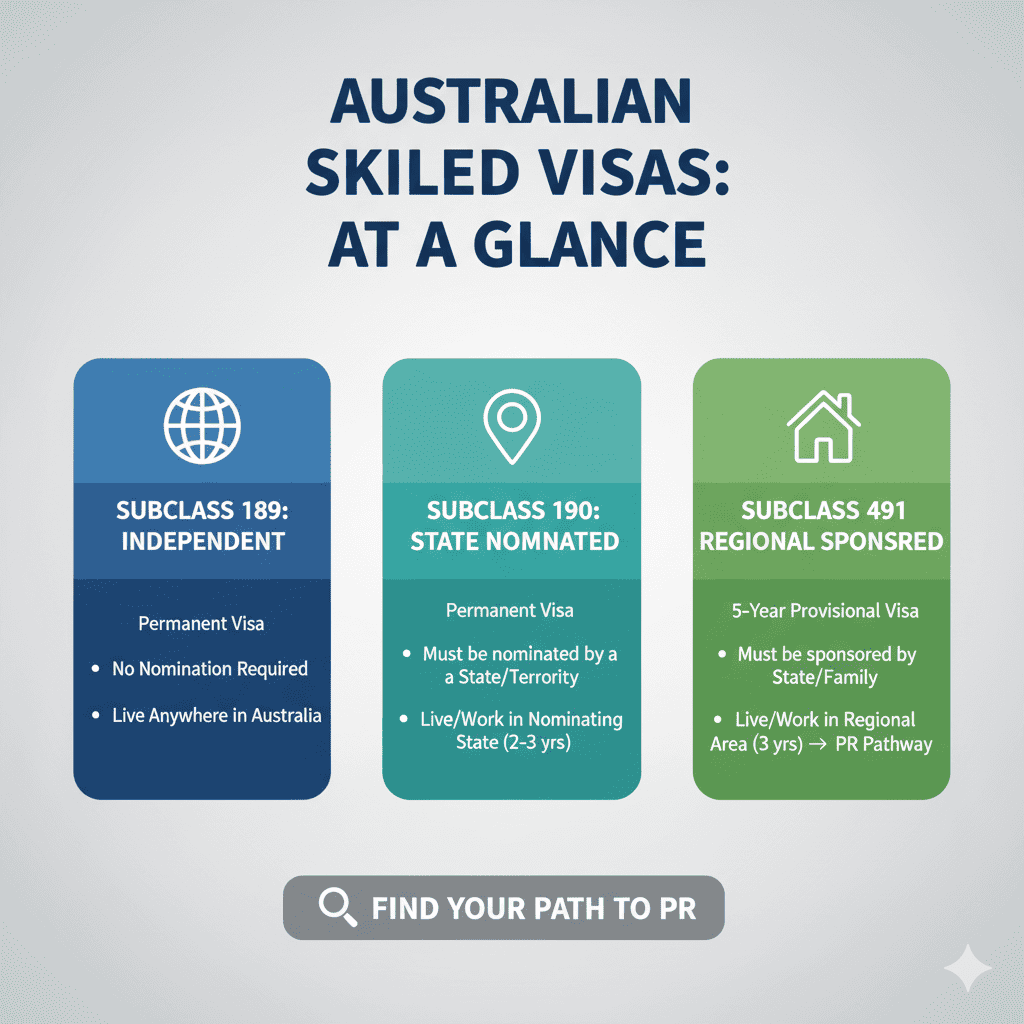Understanding Australia’s Skilled Migration Options: Subclasses 189, 190 & 491
If you’re exploring a future in Australia through skilled migration, you’ve probably come across Subclass 189, 190, and 491 visas. These three subclasses sit at the heart of the General Skilled Migration (GSM) program, which is one of the main pathways for skilled workers to secure residency in Australia. Choosing the right visa is a crucial step, as each option comes with different requirements, benefits, and long-term outcomes for you and your family.
Overview of Australia’s Skilled Visa Pathways
Australia’s GSM program is points-tested, meaning you must score a minimum of 65 points to be eligible to apply. Points are awarded based on factors like your age, English proficiency, work experience, education, and even your partner’s skills.
Another key element of eligibility is whether your occupation appears on an approved Skilled Occupation List (SOL). This ensures that applicants bring skills Australia currently needs across industries such as healthcare, engineering, and information technology.
Within the GSM framework, the Subclass 189, 190, and 491 visas are the most popular skilled migration routes. They differ in terms of sponsorship requirements, residency outcomes (permanent vs provisional), and the flexibility you’ll have in choosing where to live and work.
When to Consider Each Visa — At a Glance
To help you quickly understand the distinctions, here’s a snapshot of when each subclass may suit you best:
- Subclass 189 (Skilled Independent Visa):
Ideal if you want complete independence. This visa does not require employer, family, or state/territory sponsorship. If you meet the points requirement and your occupation is in demand, you can obtain permanent residency and live or work anywhere in Australia from day one. - Subclass 190 (Skilled Nominated Visa):
Suitable if you’re open to living in a specific state or territory. This visa requires state or territory nomination, which also boosts your points score. Like the 189, it grants permanent residency, but you commit to living in your sponsoring state for an initial period. - Subclass 491 (Skilled Work Regional Provisional Visa):
Designed for those willing to build their future in regional Australia. It’s a provisional visa valid for five years, requiring either state nomination or sponsorship from an eligible relative living in a regional area. After meeting work and residence requirements, you can apply for permanent residency through the Subclass 191 visa.
At a Glance: Subclass 189 vs 190 vs 491
| Visa Subclass | Sponsorship Requirement | Residency Type | Where You Can Live/Work | Best Suited For |
| Subclass 189 – Skilled Independent | None required | Permanent Residency | Anywhere in Australia | Applicants with high points and in-demand occupations who want independence |
| Subclass 190 – Skilled Nominated | State/Territory nomination required | Permanent Residency | Must live/work in nominating state initially | Applicants with moderate points who want faster chances through state nomination |
| Subclass 491 – Skilled Work Regional (Provisional) | State/Territory nomination or eligible family sponsorship | Provisional (5 years) → pathway to PR (Subclass 191) | Regional Australia only | Applicants flexible about location and looking for a step-by-step PR pathway |
Visa-by-Visa Breakdown
When deciding between Subclass 189, 190, and 491 visas, it helps to look at each option closely. Below you’ll find the eligibility requirements and benefits of each visa to help you understand which pathway best suits your circumstances.
Subclass 189 — Skilled Independent Visa
Eligibility & Requirements:
- You must score at least 65 points on the migration points test (factors include age, English, qualifications, and skilled work experience).
- Your occupation must be listed on the Medium and Long-Term Strategic Skills List (MLTSSL).
- You need a positive skills assessment from the relevant assessing authority.
- You must be under 45 years old at the time of invitation.
- No sponsorship or state nomination is required — this is a fully independent visa.
Benefits:
- Grants you permanent residency immediately.
- You can live, work, and study anywhere in Australia without restrictions.
- Access to Medicare, family sponsorship rights, and a pathway to citizenship.
- Flexibility to change jobs or move states without obligations.
👉 If you have a high points score and want complete independence, the 189 visa is often the most attractive choice.
Subclass 190 — Skilled Nominated Visa
Eligibility & Requirements:
- You must also score at least 65 points, but nomination from an Australian state or territory government is mandatory.
- Your occupation must appear on the nominating state’s occupation list.
- You must commit to living and working in the nominating state for a minimum period (usually two years).
- You need a skills assessment and must be under 45 years old.
Benefits:
- Provides permanent residency with similar rights to the 189 visa.
- State nomination gives you an extra 5 points, improving your chances of receiving an invitation.
👉 If your points are slightly lower, or your skills are in high demand in a particular state, the 190 visa can be a practical and strategic choice.
Subclass 491 — Skilled Work Regional (Provisional) Visa
Eligibility & Requirements:
- You must have state/territory nomination OR sponsorship from an eligible family member living in regional Australia.
- Minimum 65 points, with an additional 15 points awarded for regional nomination or family sponsorship.
- Your occupation must be on the regional occupation list.
- You must live and work in regional Australia for at least 3 years before you can apply for permanent residency (Subclass 191).
Benefits:
- A five-year provisional visa that allows you to live, work, and study in designated regional areas.
- Extra points from nomination or sponsorship often make it easier to qualify compared to 189 or 190.
- Provides a pathway to permanent residency after meeting income and residency requirements.
👉 If you’re open to regional living and want a step-by-step route to permanent residency, the 491 visa could be your best option.
Quick Comparison Table
| Feature | Subclass 189 | Subclass 190 | Subclass 491 |
| Visa Type | Permanent Residency | Permanent Residency | Provisional (5 years) → PR via Subclass 191 |
| Sponsorship/Nomination | Not required | Required (State/Territory) | Required (State/Territory or eligible family) |
| Occupation List | Medium & Long-Term Strategic Skills List (MLTSSL) | State-specific lists (may include MLTSSL, STSOL, ROL) | Regional/State lists (broadest access) |
| Points Test | Yes (minimum 65 points) | Yes (minimum 65 points + 5 for nomination) | Yes (minimum 65 points + 15 for nomination or sponsorship) |
| Age Limit | Under 45 | Under 45 | Under 45 |
| English Proficiency | Competent (IELTS 6.0 or equivalent) | Competent (IELTS 6.0 or equivalent) | Competent (IELTS 6.0 or equivalent) |
| Skills Assessment | Required | Required | Required |
| Work/Study Rights | Anywhere in Australia | Anywhere in Australia but it comes with an initial obligation to live and work in the state or territory that nominated you | Designated regional areas only |
| PR Pathway | Direct | Direct | After 3 years in regional Australia via Subclass 191 |
| Ideal For | High points, in-demand national occupation | Willing to commit to a state, state-listed occupation | Open to regional living, seeking a clear PR pathway |
Decision-Making: Selecting the Right Visa
Choosing the right skilled visa is a pivotal step in your Australian migration journey. It hinges on aligning your personal profile, career aspirations, and long-term goals with the specific requirements and benefits of each visa subclass. Let’s delve into the key factors to consider:
Evaluate Your Eligibility & Profile
Begin by assessing your individual circumstances against the eligibility criteria for each visa subclass:
- Subclass 189 (Skilled Independent): Ideal for applicants with a high points score (typically 90+), as it offers maximum flexibility without the need for state or employer sponsorship. This visa is suitable if your occupation is in demand nationally and you prefer to live and work anywhere in Australia.
- Subclass 190 (Skilled Nominated): Requires state or territory nomination. If your occupation is in demand in a specific state and you are willing to commit to living and working there for at least two years, this visa can be a strategic choice. The state nomination provides an additional 5 points, enhancing your chances of receiving an invitation.
- Subclass 491 (Skilled Work Regional – Provisional): A provisional visa requiring state or family sponsorship. If you’re open to living and working in regional Australia for at least three years, this visa offers a pathway to permanent residency through the Subclass 191 visa. The 491 visa provides an additional 15 points for state or family sponsorship, making it a viable option for many applicants.
Consider factors such as your occupation’s presence on the relevant Skilled Occupation List, your age, English proficiency, and work experience.
Assess Your Flexibility & Long-term Goals
Your willingness to relocate and your long-term aspirations play a crucial role in selecting the appropriate visa:
- Flexibility: If you value the freedom to choose your location within Australia, the Subclass 189 visa offers the most flexibility. However, securing an invitation may be competitive, requiring a higher points score.
- State Commitment: If you’re open to living in a specific state for a defined period, the Subclass 190 visa provides a direct route to permanent residency with state support.
- Regional Living: If you’re willing to live and work in regional areas, the Subclass 491 visa not only offers a pathway to permanent residency but also provides additional points, increasing your chances of receiving an invitation.
Aligning your visa choice with your lifestyle preferences and career goals is essential for a successful migration experience.
Consider Practical Scenarios
Let’s explore some practical scenarios to illustrate how different profiles align with each visa subclass:
- Scenario 1: A software engineer aged 30 with a high English proficiency score and 90 points
Recommended Visa: Subclass 189
Rationale: The applicant’s high points score and in-demand occupation make them a strong candidate for the Subclass 189 visa, offering the flexibility to live and work anywhere in Australia. - Scenario 2: A registered nurse aged 35 with 75 points and a state nomination from New South Wales
Recommended Visa: Subclass 190
Rationale: The applicant’s occupation is in demand in New South Wales, and the state nomination provides an additional 5 points, enhancing their chances of receiving an invitation. - Scenario 3: An agricultural scientist aged 40 with 70 points and sponsorship from a family member in regional Queensland
Recommended Visa: Subclass 491
Rationale: The applicant’s willingness to live and work in regional Queensland, combined with family sponsorship, makes the Subclass 491 visa a suitable choice, offering a pathway to permanent residency.
These scenarios highlight how individual circumstances can influence the optimal visa choice.
Navigating the complexities of Australia’s skilled migration program can be challenging. Blue Orbit Services offers personalized guidance to help you assess your eligibility, understand the nuances of each visa subclass, and develop a tailored strategy that aligns with your professional and personal goals. Whether you’re aiming for the flexibility of the Subclass 189, the state support of the Subclass 190, or the regional opportunities of the Subclass 491, Blue Orbit Services is here to assist you every step of the way.
Next Steps & Practical Tips
Once you have evaluated your eligibility and compared the Subclass 189, 190, and 491 visas, the next step is to take practical action to improve your chances and make the application process smoother. Here are the key strategies and tips you should consider:
1. Submit a Strong Expression of Interest (EOI)
Your first formal step in the skilled migration pathways in Australia is submitting an EOI through SkillSelect. This allows immigration authorities to assess your points score and determine if you qualify for a visa invitation.
- Make sure your points score is accurate, including your age, work experience, qualifications, and English language proficiency.
- Highlight any extra points you may be eligible for, such as partner skills, regional study, or professional accreditation.
- Regularly update your EOI if your circumstances change, like gaining additional work experience or improving English scores.
Tip: A well-prepared EOI can increase your chances of being invited for your preferred visa subclass, whether it’s 189, 190, or 491.
2. Improve Your Points Score Where Possible
A higher points score gives you a better chance of receiving an invitation for skilled visas. Consider the following:
- English proficiency: Higher IELTS, PTE, or TOEFL scores can boost your points.
- Professional experience: Gaining additional years in your nominated occupation can add valuable points.
- Qualifications: Completing recognized Australian study or higher education can increase eligibility points.
- Partner skills: If your partner meets English and skill requirements, you can add points.
- NAATI accreditation: Becoming certified by NAATI as a translator or interpreter for a community language can earn you extra points.
Even a small increase in your points score can make the difference between a successful 189, 190, or 491 application.
3. Stay Updated on State Nomination Lists and Regional Opportunities
If you are considering the Subclass 190 or 491 visa, monitoring the state and territory nomination requirements is critical:
- Each state updates its Skilled Occupation Lists regularly. Your occupation must appear on the list to qualify for nomination.
- States may prioritize occupations in demand, which can give you a competitive advantage.
- For the 491 visa, explore regional opportunities, since living and working in regional areas can also increase your points and PR pathway options.
Note: Regional Australia offers not just higher points for provisional visas but often better job prospects and local support.
4. Prepare Your Documents Carefully
Your visa application will require thorough documentation to prove eligibility:
- Skills assessment: Conducted by the relevant assessing authority for your occupation.
- Employment references and work experience letters: Should include dates, responsibilities, and hours worked.
- Educational qualifications: Certified copies of your degree or diploma.
- English language test results: IELTS, PTE, or TOEFL scores.
Ensuring your documents are complete and verified can prevent delays or refusals.
5. Seek Expert Guidance When Needed
Navigating Australia’s skilled visa application process can be complex, especially with multiple visa options, changing state requirements, and points variations. You can:
- Consult a registered migration agent or specialist for personalized advice.
- Get help evaluating which visa — 189, 190, or 491 — aligns best with your profile and career goals.
- Understand the latest rules and procedural updates to avoid mistakes.
For example, Blue Orbit Services offers end-to-end support across skilled migration pathways, including guidance on EOI preparation, state nomination, regional visas, and documentation, helping you take the next step with confidence.
6. Keep Track of Timelines and Application Deadlines
- Visa invitations can have tight deadlines for response.
- Track your EOI status regularly and submit visa applications promptly once invited.
- Plan for processing times, which vary by subclass: 189 and 190 visas often process faster than 491, which is provisional but leads to PR after 3 years.
Staying organized and proactive reduces stress and improves your chance of a smooth application.
Summary & Key Takeaways
Choosing the right skilled migration visa is a crucial step in your journey toward permanent residency in Australia. By understanding the differences between Subclass 189, 190, and 491, you can make a decision that aligns with your career goals, lifestyle preferences, and long-term plans.
Here’s a clear breakdown to help you summarize your options:
Subclass 189 — Skilled Independent Visa
- Ideal if you have a high migration points score and want full flexibility to live and work anywhere in Australia.
- You do not need state or territory sponsorship, making the process straightforward if your occupation is on the MLTSSL or Skilled Occupation List (SOL).
- Provides permanent residency immediately, along with access to Medicare, the ability to sponsor family, and a pathway to citizenship.
Subclass 190 — Skilled Nominated Visa
- Best suited if your points score is moderate but your occupation is in demand in a specific state or territory.
- Requires state nomination, which gives you extra points and increases your chances of receiving an invitation through SkillSelect.
- You must commit to living and working in the nominating state for a specified period, but you gain permanent residency and the same benefits as Subclass 189 once the visa is granted.
Subclass 491 — Skilled Work Regional (Provisional) Visa
- Works well if you are flexible about regional living and are looking for a stepwise pathway to permanent residency.
- Requires either state/territory nomination or eligible family sponsorship.
- You can live, work, and study in designated regional areas for up to five years, then apply for Subclass 191 to achieve permanent residency.
- Many applicants benefit from expert guidance to navigate regional occupation lists and nomination requirements effectively.
Key Takeaways for Your Decision
- Match your points and profile to the visa: High-scoring applicants may prefer Subclass 189, while moderate scores can leverage Subclass 190 or 491.
- Consider location flexibility: 189 offers nationwide freedom, 190 ties you to a state initially, and 491 focuses on regional areas.
- Think long-term: All visas provide a pathway to permanent residency, but the timeline and conditions differ.
- Seek guidance when needed: Navigating the eligibility requirements, state nominations, and points-tested criteria can be complex. Expert support can help you maximize your chances and make informed decisions.
By keeping these points in mind, you can approach your skilled visa application with confidence. Understanding the differences, benefits, and obligations of each visa ensures you select the one that best fits your skills, lifestyle, and career aspirations in Australia.
Remember, your choice now affects your long-term PR pathway, work opportunities, and life in Australia, so take the time to evaluate your options carefully.

About the Author:
Kunal is an Australian Solicitor with over 10 years of legal experience in both Australia and abroad. Admitted to the Supreme Court of Victoria, he uses his unique background to help businesses, professionals, and individuals with their legal, commercial, and migration needs.




